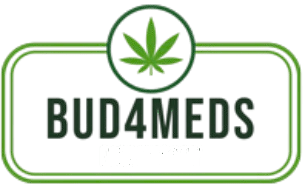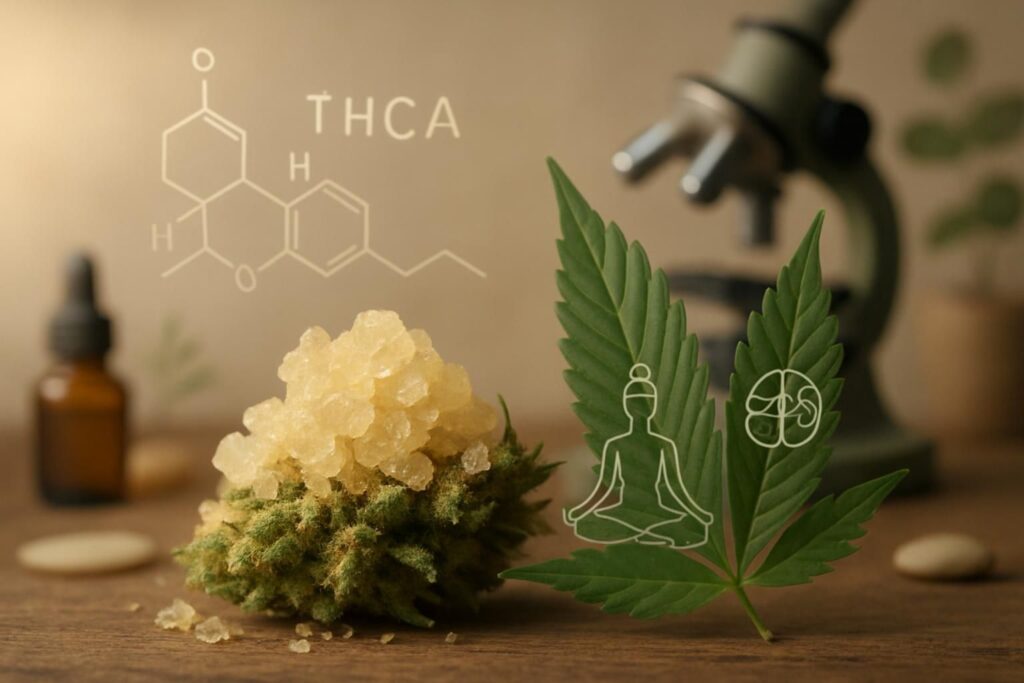The nuanced relationship between THCA and THC often gets overlooked despite being fundamental to understanding the cannabis plant’s chemistry and effects. While the names differ by a single letter, their impact on the body couldn’t be more distinct. THCA—tetrahydrocannabinolic acid—is the non-psychoactive precursor found abundantly in raw cannabis. It is the fresh, unheated form that stores in the flowers and leaves, effectively unable to produce the characteristic “high” that THC delivers once activated. On the other hand, THC, or tetrahydrocannabinol, is the compound responsible for cannabis’ psychoactive effects, created through a transformation process known as decarboxylation.
This difference isn’t merely semantic; it drastically impacts consumption methods, user experience, and potential applications. Cannabis consumers seeking recreational or medical effects rely primarily on THC, while those interested in the therapeutic benefits without intoxication may turn to THCA. Despite this, many underestimate the role of THCA in the overall cannabis ecosystem, partly because it’s less stable and often overlooked in testing and product labeling.
Compound | Presence in Cannabis | Psychoactive? | Common Effects |
|---|---|---|---|
THCA | Raw Cannabis Flower and Leaves | No | Potential Anti-inflammatory, Neuroprotective |
THC | Heated Cannabis Products | Yes | “High,” Euphoria, Altered Perception |
Understanding the difference also means appreciating how cannabis is consumed and the chemistry behind that. For example, uncooked cannabis flower with mostly THCA will not cause any intoxication if ingested without heating, highlighting the importance of activation for psychoactivity. This distinction supports why raw cannabis juicing or tinctures are becoming popular among those seeking health benefits of cannabis without the high.
THCA vs THC: Understanding the Non-Psychoactive Precursor and Its Transformation
At first glance, THCA and THC might seem like nearly identical compounds due to nomenclature, but their chemical structures diverge significantly. THCA contains a carboxyl group (-COOH) that renders it unable to bind effectively to brain receptors responsible for psychoactive effects. In contrast, THC lacks this group, enabling it to fit perfectly into cannabinoid receptors.
An easy way to conceptualize this is imagining a “square peg in a round hole.” The THCA molecule is like the square peg that simply does not fit into the round CB1 receptor hole in the brain, preventing the classic cannabis “high.” THC is the round peg, fitting seamlessly, triggering the receptor and leading to psychoactive effects.
THCA is the raw, acidic form mainly found in fresh cannabis plants.
THC forms after heat-induced transformation.
THCA is non-psychoactive; THC produces the high.
THCA may offer unique benefits distinct from THC.
Both molecules are cannabinoids integral to the plant’s interaction with the human body, yet their roles differ. While THC‘s psychoactive effects are well-documented and commonly explored here, THCA is emerging as a promising therapeutic agent with less attention but growing interest.

Decarboxylation and Chemical Differences: How THCA Becomes the Psychoactive THC
The transition from THCA to THC hinges on a chemical reaction called decarboxylation. This process involves heating cannabis, which removes the carboxyl group (-COOH) from THCA, turning it into the psychoactive THC capable of binding to cannabinoid receptors. Without this step, THCA remains inert in terms of producing a high.
There are two common decarboxylation methods:
Traditional Burning (Smoking): Direct combustion instantly heats cannabis to temperatures that decarboxylate THCA but also destroy some compounds, including aromatic terpenes.
Controlled Oven Heating: Low-temperature baking (typically 220–240°F or 104–116°C for 30–40 minutes) transforms THCA gradually and more thoroughly, preserving potency and flavor.
Understanding this distinction improves consumption efficiency and potency, especially important when using cannabis for specific benefits rather than recreational use. Oven decarboxylation allows for more precise dosing and use in food products, tinctures, or oils without the harmful byproducts of smoking, which carries health risks explored here.
Decarboxylation Method | Temperature Range | Advantages | Disadvantages |
|---|---|---|---|
Burning/Smoking | 600–900°C (varies) | Instant Activation, Common Method | Loss of Terpenes, Health Risks from Smoke |
Oven Decarboxylation | 104–116°C for 30-40 min | Preserves Potency, Flavor, Controlled Activation | Requires Time, Equipment |
With vaping gaining popularity as a healthier alternative to smoking, understanding the decarboxylation temperature range is crucial for effective use of cannabis concentrates or flower learn more about vaping here. Vaporizers offer controlled heat settings that support efficient THCA conversion without combustion.
Forms, Uses, and Potential Benefits of THCA vs THC: Safety, Effects, and Legal Considerations
THCA exists in several forms beyond raw cannabis flower, expanding its applications:
Raw Cannabis Flower: High in THCA, consumed via juicing or tinctures for non-psychoactive benefits.
THCA Diamonds: Crystalline concentrates with very pure THCA.
Edibles and Patches: Some products contain THCA, designed for targeted, prolonged benefits.
Users can consume these forms for various therapeutic reasons, such as anti-inflammatory and neuroprotective effects, potentially aiding in conditions like arthritis or neurological disorders. Early research and anecdotal evidence suggest THCA also exhibits anti-nausea and metabolic benefits, though rigorous human studies remain limited see research importance here.
In comparison to cannabinoids like CBD, which is also non-intoxicating and acclaimed for its wellness properties explored in detail here, THCA represents a promising but less understood therapy, especially given its unique chemical profile.
Aspect | THCA | THC |
|---|---|---|
Psychoactivity | No | Yes |
Medical Potential | Anti-inflammatory, Neuroprotective, Anti-nausea | Pain Relief, Appetite Stimulation, Mood Alteration |
Side Effects | Possible Nausea, Skin Irritation, Medication Interactions | Dry Mouth, Anxiety, Cognitive Impairment |
Legal Status | Varies; often legal if hemp-derived | Heavily Regulated/Illegal in Some Areas |
Safety considerations remain paramount. While raw THCA generally lacks intoxicating risks, it may cause side effects such as nausea, skin irritation, or respiratory symptoms in sensitive individuals. Furthermore, THCA may interact with other medications, underscoring the importance of conscientious consumption and awareness of common drug side effects discussed here.
Conversely, THC consumption can lead to issues such as anxiety, hallucinations, or motor skill impairment, especially in high doses or inexperienced users. Both cannabinoids demand responsible use, particularly given the variability in potency and labelling accuracy due to the relatively unregulated cannabis market. Staying informed can prevent unintended consequences and optimize outcomes. This aligns with broader societal impacts explored in legalization studies and recreational use dynamics here.
The legal landscape differentiates mostly based on plant source and cannabinoid content. Hemp plants contain less than 0.3% THC, which means their THCA content is non-intoxicating and often legally sold across many regions. Some individuals exploit this by converting hemp-sourced THCA into THC through heating, creating legal grey areas where marijuana remains illicit but hemp products don’t. Understanding local regulations is vital before purchasing or consuming any cannabis-derived substances.
Related cannabinoids such as Delta-8 THC and Delta-9 THC also factor into these considerations. Delta-9 THC is the primary, most potent psychoactive component in marijuana, while Delta-8 THC offers a milder alternative with similar effects but less legal clarity. Importantly, THCA itself remains inactive until heated. This biochemical transformation underpins the entire spectrum of cannabis experiences.
Summary Table: Key Differences Between THCA, THC, Delta-8 THC, and CBD
Cannabinoid | Psychoactivity | Common Sources | Typical Effects | Legal Status |
|---|---|---|---|---|
THCA | No | Raw Cannabis Flowers | Anti-inflammatory, Neuroprotective | Often Legal if Hemp-Derived |
THC (Delta-9) | Yes, Strong | Heated Cannabis Products | Euphoria, Altered Perception | Regulated or Illegal in Many Areas |
Delta-8 THC | Yes, Mild | Processed Hemp Products | Relaxing, Less Anxiety | Legal Grey Areas |
CBD | No | Hemp Plants | Anti-inflammatory, Anti-anxiety | Widely Legal |
Frequently Asked Questions
What happens if I consume raw cannabis containing only THCA?
Consuming raw cannabis means ingesting mostly THCA, which does not produce a psychoactive high. Many use raw cannabis for potential health benefits without intoxication.How can I convert THCA into THC at home?
Applying low heat through oven decarboxylation or vaporization can convert THCA to THC. Temperatures around 220–240°F for 30-40 minutes are optimal for this process.Is THCA legal like hemp products?
Typically, THCA from hemp, containing less than 0.3% THC, is legal in many places. However, local regulations vary, so checking state or national laws is essential.What side effects might THCA cause?
Possible side effects include nausea, skin irritation, or respiratory discomfort. It’s important to consult healthcare providers, especially if taking other medications to avoid interactions.How does THCA compare to CBD?
Both are non-psychoactive cannabinoids with potential therapeutic benefits. While CBD is widely studied, THCA shows promise, especially in anti-inflammatory and neuroprotective properties.

